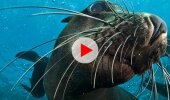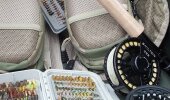Words: Alan Hobson | Photos: Courtesy of Angler & Antelope
When you arrive at a dam in winter, you will often spot groups of fish cruising around the water's edge looking for a suitable area to erupt into spawning. They are not being hospitable by showing themselves, even though they don’t appear to be concerned about you, they are completely distracted by the call of nature.
Photo credit: Courtesy of Angler & Antelope
Winter conditions bring about spawning trout that are driven by hormones and survival instincts. While the hens are actively looking for suitable substrate to drop their eggs, the cock fish are all too eager to add their milt to the breeding process. Using orange coloured flies that are associated with eggs, spawning and aggression, fly fisherman tend to fish attractor patterns and retrieve the fly a lot faster, capitalising on the aggressive behaviour of the fish.
Winter also means that certain insects are more active than others and are therefore more readily available on the trout's menu.
The success of fly fishing is largely dependent on your power of observation and being able to identify which insects are most prevalent, but at the sight of frolicking fish we somehow lose our focus and become oblivious of nature's kitchen occurring at our feet. The goggas that make up the ‘nouveau cuisine’ of the fish’s diet, in winter, are Diptera (flies), specifically midge larvae (either olive larvae or blood worm). There is also an abundance of water beetles, Coleoptera, predacious diving beetles, whirligig beetles and water scavenger beetles, as well as Hemiptera (bugs), known as corixa or water boatmen and back swimmers. Trichoptera, known as caddis flies or aquatic moths found in the water as larvae, are either cased or caseless.
On a recent fishing trip, I was sucked into the mode of frantically casting and stripping attractor patterns. The less successful I was the faster I got the fly in the water and the quicker I retrieved the fly. It must be that beanie one wears to protect one’s head and ears against the winter chill that puts blinkers on one’s brain and defrosts any logical thinking, or it could be the fact that one needs to increase one’s body temperature, hence casting furiously. Whilst you will catch the odd fish that gratuitously takes your fly out of aggression, we somehow stick to the same techniques all day; cast and strip, fast - and we thought fish had a brain the size of a pea!
There is an easier way or certainly another more effective way. Next time take an armchair, position yourself out of the wind or with your back to the wind and the sun and sit like a rock rabbit (dassie). We can learn a lot from our fellow mammals and their habits in winter. First, it feels great to have the warmth of the winter sun on your back and the wind blowing from behind you, as you can use the wind to improve your casting distance. Second, by sitting down you lower your profile at the water’s edge and are not so visible. Better still, try and find a spot behind some long grass to camouflage yourself. Third, the feeling of melting into some degree of normality with a fly in the water has a certain appeal to it.
Photo credit: Courtesy of Angler & Antelope
As for the technique, go natural and string an array of flies on a long leader of about 12 feet, using a dropper system. Attach the midge larvae imitations to the point of your leader, as they will lie on the bottom in amongst the weed. About 3 feet from the point fly, attach a caddis fly imitation as it will look as though it has left the bottom or the weed on natures’ course to the next stage of its life cycle, drifting mid water. Three feet above that, attach a small water beetle or bug imitation. Present your menu of flies along the edge, preferably near weed or structure, and leave it there. As the fish cruise the margins, they will very often feed on naturals, thus providing a higher success rate of hook ups.
Often, the wind action against your fly line lying on the surface does enough to titillate your flies to life. You can twitch your flies every now and then if there is no wind, preferably when you can see the fish coming in the direction of your offerings. While your mind melts as you bask in the sun, keep an eye on your line as you will see it tighten gently; the takes are usually very subtle. If you feel the line tighten, lift your rod to set the hook and hold on as you awaken into the reality of ‘pumped’ winter fish.
Sources:
• Aquatic Invertebrates of South African Rivers by A Gerber and MJM Gabriel, available from the Department of Water Affairs.
• Guide to aquatic Trout foods by Dave Whitlock, available from www.netbooks.co.za














